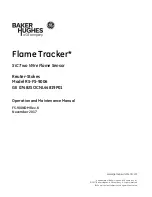
FS-9006OM
– REV K
4
1.3 GENERAL DESCRIPTION
On Liquid Dry Low Nox Applications as well as those applications with significant levels of water and steam
injection, the ultra-violet light sensed by the Geiger Mueller tube based flame detectors is absorbed by the fog
of fuel, steam or wate
r. GE’s research center invented a silicon carbide (SiC) photodiode that is significantly
more sensitive to the longer wavelength components of the UV light generated by the flame. This longer
wavelength light does penetrate the fog of oil quite well and therefore the SiC based sensor is significantly more
sensitive to the presence of flame. A flame sensor utilizing the SiC photodiode is being produced by BHGE
Reuter-Stokes, and has been successfully operated on a number of GE gas turbine installations.
2
SENSOR
Figure 1 is a block diagram of the SiC Flame Sensor. The sensor has a sapphire window that is transparent
to UV light and can withstand the compressor discharge temperature and pressure. It has a lens inside that
focuses the light on a silicon carbide photodiode in a hermetic package. The photodiode is wired to a MOSFET
input amplifier. The amplifier has a high initial gain, which automatically shifts to a lower gain in order to
accommodate a wide range of input light level without saturating. The sensor regulates the supply current in
proportion to the amount of UV light present. Both power and signal are transmitted on the same two wires. The
sensor can be powered from a dc voltage between 12 and 30 volts. The whole transducer is sealed and filled
with dry argon.
Figure 1
BLACK -
RED +
GREEN
External Signal
Conditioning
4-20mA
SiC FLAME TRACKER
TM
WIRING DIAGRAM
A
B
C
D
E
4-20mA
BARE
WIRE
































